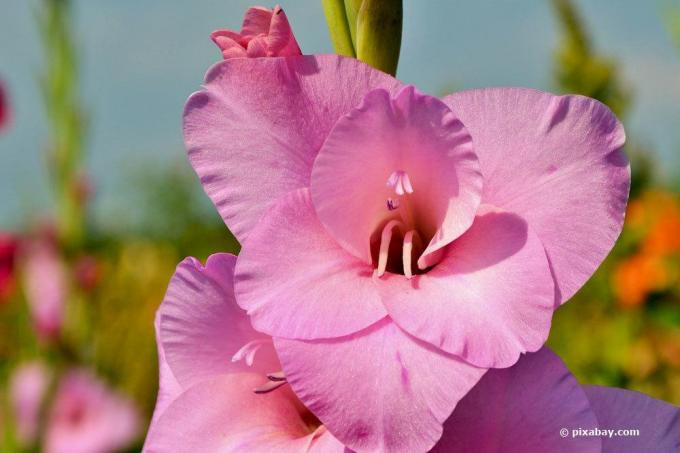
table of contents
- Heyday
- Early blooming gladioli
- Late blooming gladioli
- Garden gladiolus
- No gladiolus blossom
- causes
Gladioli are very popular because of their characteristic flowers. The plants, which come from southern Europe and Africa, have evolved over the course of their cultivation until after Central Europe spread out and with the marsh and meadow victoria the only two species are found in Germany. If you've decided to grow irises, you'll be excited to see when the plants will bloom and what to do if they don't.
Heyday
Gladioli belong to the plant genera that do not have a fixed flowering period, but a flowering period in which the various species bloom. The point in time when the gladiolus flowers appear differs from species to species. You should take advantage of this when designing your garden. There are two dates during the year when you can look forward to the flowers of the genus:
- early species bloom from May to June
- late species bloom from late June or early July to September
The iris family (bot. Iridaceae) around sun-drenched plants that show their flowers especially when the weather is nice. For this reason, the weather can have a significant impact on the flowering time and even delay it. The earliest gladioli appear after the Ice Saints, as they cannot withstand frost and can even be damaged by it. Below you will find a small overview of possible species that bloom early.
Early blooming gladioli
- Byzantine Siegwurz (bot. G. communis)
- Seed gladiolus (bot. G. italicus)
- Illyrian Siegwurz (bot. G. illyricus)
- Marsh ventriloquist (bot. G. palustris)

It is precisely the original species whose flowering time begins at the end of May and which quickly creates a veritable sea of flowers in the garden. The following taxa, on the other hand, only show up later in the year and are particularly inspiring when it is really warm outside:
Late blooming gladioli
- Large-flowered gladiolus hybrids
- Varieties of the Nanus group
- Cultivars of the Primulinus Group
- Butterfly gladiolus (bot. G. papilio)
Garden gladiolus
The only exception is the garden gladiolus (Gladiolus hortulanus) with its numerous varieties. These are not limited to a specific period and bloom without any problems from the end of May or the beginning of June until October. This is what makes the garden gladiolus such a popular plant because it can really inspire you with its blooming flowers throughout the summer. You only need the necessary care for this. The garden gladioli are divided into four groups:
- Butterfly gladiolus
- Baby gladioli
- Wild gladioli
- Noble gladiolus
These also offer a large selection of varieties. The most popular include:
- Perseus
- Blackpool
- Lady Godiva
- Guernsey Glory
- Nymph
- atom
This gives you a large number of taxa available with which you can equip your beds and even vary them. Take your time when planning the gladiolus beds, because this allows you to determine exactly how they will look in the end. The early blooming irises bloom for a period of about two to four weeks and can then present their picturesque blooms again until the end of the season. The late species bloom for four to ten weeks, but do not develop a second iris bloom. Your favorite variety will surely be there and beautify the garden accordingly.

tip: The Wiesensiegwurz (bot. Gladiolus imbricatus) is an ideal species with which you can bridge the flowering period between the early and late gladioli. They bloom between mid-June and mid-July and ensure that you can enjoy the irises all summer long.
No gladiolus blossom
Irises belong to the demanding plants and can be due to care errors or incorrect location conditions blooming lazy will. Even small mistakes can prevent the iris bloom and spoil your enjoyment of the plants.
causes
1. Planted too early
Have you planted your bulbs in April? If so, you will have to wait a little longer for the picturesque gladiolus flowers because the shoot may have been damaged by late frosts. In the worst case, the onions and thus the entire specimen were damaged. Remember: Always plant out from the beginning of May, otherwise the flowering will not take place this year or it will come much later.
2. Not enough sun
Gladioli are true sun worshipers and need a place in direct sun, otherwise they will be lazy to flower. They must also be protected.
3. Set too flat
The irises must be sunk deep enough into the earth to find support. So plant your specimens twice as deep in the ground as the bulb is wide. Otherwise it will not be able to anchor itself and absorb sufficient nutrients, which will delay flowering.
4. Withered flowers
A gladiolus always forms the flowers from bottom to top. Often the lower flowers wither, which stops the growth of the upper buds, as all the energy is put into seed formation. Immediately remove withered flowers to allow adequate energy for top flowers.
5. Nutritional deficiency
Do not forget to provide the planting site with sufficient nutrients. Because the hungry plants need a lot of nutrients in order to develop the beautiful flowers. It is best to spread a load of ripe compost or horn meal to stimulate the vitality of the plant.

tip: Do not be surprised if you are cared for correctly and if the gladiolus species take longer to open their flowers. When the gladiolus blooms does not only depend on the weather and care, it also depends on the game Soil conditions and the quality of the onion matter what makes it impossible to make the final one Predict flowering time.



